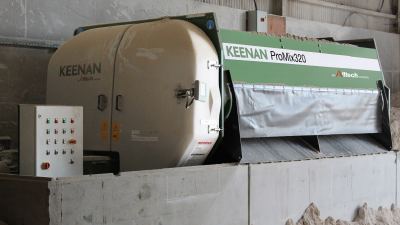Media & Events
Rumen Manipulation

Through an increased understanding of rumen metabolism, numerous attempts have been made to manipulate rumen function in order to improve animal performance through increased feed intake or an improved supply of end products of digestion to the animal. These aims can clearly be achieved by optimal ration formulation.
A key driver of rumen function is the balance between the supply of ruminal degradable protein and soluble carbohydrates. This has a significant impact on protein supply to the animal through resultant variation in microbial protein production. At the same time, the need to promote rumination to stimulate feed intake and further support efficient rumen function needs to be recognised. Therefore, maintaining sufficient dietary levels of structural fibre is critical to avoid large reductions in rumen pH associated with feeding excess soluble carbohydrates. In such situations, TMR feeding has an important role to play.
Many different feed additives have been proposed and a resume of their effects would not be appropriate within the context of this short review. However, some are worthy of mention. A common example is the dietary addition of yeast (Yea-Sacc) in order to augment the buffering capacity of the rumen. This approach has been shown to be effective in most situations with a correctly balance ration. earch studies have shown that despite similar intakes of the same mixed feed to those being consumed by later-lactation cows producing lower levels of milk, when all cows were challenged with the same amount of an additional high starch feed source, the higher yielding cows were less able to maintain rumen pH levels. This may suggest that the mineral need of the higher yielding cows was compromised and in such situations, use of feed buffers to support rumen buffering capacity is appropriate.
In a similar way, there has been considerable interest over the last few years in the use of yeasts to improve rumen fermentation. Earlier research has shown that despite low levels of addition, yeasts or yeast cultures are effective within the rumen environment. Several effects have been suggested including uptake of stray oxygen, improved fibre digestion through enhanced activity of fibrolytic microbes and control of lactic acid levels on high starch rations. In respect of lactic acid metabolism, research evidence has shown the numbers of lactate utilising bacteria are increased by yeast supplementation yet other studies have reported increased numbers of lactate producers. Overall effects on feed intake, milk yield and milk composition were generally highly positive. One notable effect being an improvement in acid detergent fibre digestibility.
Methane is an unavoidable end-product of enteric fermentation and its production from ruminants has attracted attention from both consumers and political powers. Reducing methane production should, theoretically, increase the total energy available from the ration, as well as reduce the environmental impact. There has been much research into reducing methane output from ruminants, not least through nutrition with a number of approaches having been considered. Use of halogenated compounds was considered to be effective against methanogenic microbes but most of the effects noted were transient and this approach has not been continued. Recent research in Australia has focussed on the immunisation of animals against methanogenic archaea with original claims of a total elimination of methane production. However, the alternative metabolic fate of both carbon and hydrogen produced from fermentation, and whether there was a subsequent effect on animal performance, was not made clear. More recently the claims for immunisation have been seriously down-sized and latest research claims only a 7.7% reduction in methane production, a response which could be achieved through improved nutritional management.
Other suggested strategies to reduce methane production have included the introduction of methane oxidising bacteria into the rumen, or acetogens, known to increase acetate production at the expense of carbon dioxide disposal via methane production. Defaunation, which involves the removal of protozoa, has also been proposed as protozoa provide an important environmental niche for rumen methanogens. In this respect, studies which have increased the level of free oil in the ration have been shown to reduce protozoal numbers with a concomitant decline in methane production, the effects being particularly pronounced with coconut oil. Defaunation has also been shown to improve microbial protein supply to the intestines due to a significant reduction in protein turnover by the rumen microbial population. However, recent work demonstrates that significant changes to the microbial ecosystem, such as defaunation, are only transient and the rumen will revert to its prior state. Additionally, research has shown that it may also be unwise to focus primarily on reducing methane – a rumen that exhibits reduced methane production isn’t necessarily more efficient. There is, currently, much focus on whole systems and how the rumen microbial ecosystem influences gross parameters, such as methane emission and production efficiency. The Ruminomics EU FP7 project has delivered some excellent work on this topic.
Conclusions
This short report has attempted to present some of the underlying principles of rumen function and the important role it has in determining overall feeding value. The intimacy between energy (carbohydrate) and protein metabolism in the rumen should not be underestimated as this can seriously impact upon the nature as well as the quantity of nutrients absorbed from the GI tract and made available to the host animal. It is evident from this report that the rumen is the major site of digestion and provides justification for efficient feeding of the rumen ecosystem if overall performance of the animal is to be optimised.
Author: Denis Dreux

























